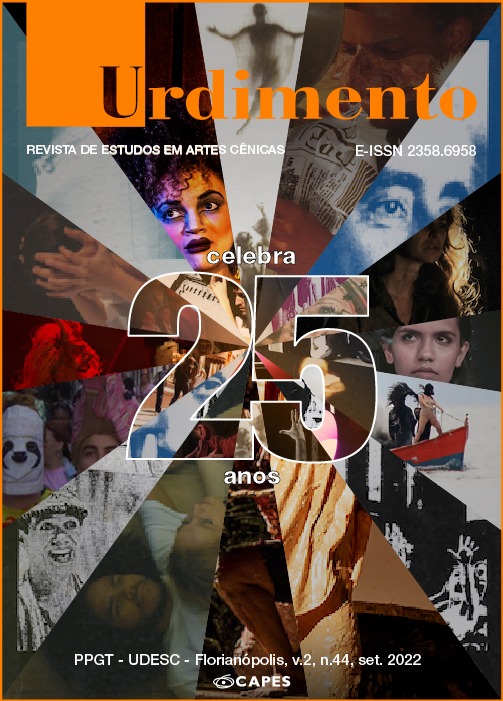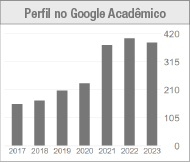Dialogues between the creation of comic videos on TikTok and the concept of gag in clowning
DOI:
https://doi.org/10.5965/1414573102442022e0200Keywords:
Clowning, Gag, TikTok, Comic, PerformanceAbstract
This article aims to establish a dialogue between the process of creating comic videos on TikTok and the concept of gag in clowning, seeking to reflect on the different possibilities of building the comic effect at the intersection between the practices of clowning and short videos. The study's starting point was my experience with creating videos on the platform, which made me question myself about the use of imitation, which is a common element in creating short videos, and the different versions produced through the appropriation of other jokes. Based on theoretical investigations, this research discusses the concepts of the gag, the internet meme and the comic performance to contextualize the report of three experiments carried out by the clown Hipotenusa, interpreted by me, seeking to contribute to studies on comic creation in digital media.
Downloads
References
ALBO-COS, Úrsula. Cambio de perspectiva, comedia e interseccionalidad de #Esperancita en TikTok. Virtualis,11 (21), 52-67. ISSN 2007-2678, 2020.
BALDUCCI, Anthony. The funny parts: A history of film comedy routines and gags. McFarland, 2014.
BARBOSA, Ana Carolina Carvalho Torres. Discussões sobre a noção de autoria no palhaço. VI Congresso de Pesquisa e Pós-Graduação em Artes Cênicas-ABRACE. 2010. Disponível em: https://www.publionline.iar.unicamp.br/index.php/abrace/article/view/3488. Acesso em 13 março. 2022.
BERGSON, Henri. O riso: Ensaio sobre o significado do cômico. Trad. Maria Adriana Camargo Cappello. São Paulo: Edipro, 2018.
BERNAL, Óscar C. O corpo invisível: teatro e tecnologias da imagem. Urdimento - Revista de Estudos em Artes Cênicas, Florianópolis, v. 2, n. 11, p. 177-189, 2018. DOI: 10.5965/1414573102112008177. Disponível em: https://www.revistas.udesc.br/index.php/urdimento/article/view/1414573102112008177. Acesso em: 14 maio 2022.
BOUISSAC, Paul. The Semiotics of clowns and clowning: rituals of transgression and the theory of laughter. Bloomsbury Publishing, 2015.
CANALTECH. Tudo sobre TikTok. Disponível em: <https://canaltech.com.br/empresa/tiktok/>. Acesso em: 10 abr. 2022.
CARDOSO, Cristina. Quem não se comunica… se trumbica. Boca Larga: tempos de pandemia. São Paulo, v. 8, n. 1, p. 30-31, mai. 2020. Disponível em: https://doutoresdaalegria.org.br/wp-content/uploads/2020/12/Boca-Larga-Tempos-de-Pandemia.pdf. Acesso em: 10 abr. 2022.
KASPER, Kátia Maria. Experimentações clownescas: os palhaços e a criação de possibilidades de vida. Tese (Doutorado) - Universidade Estadual de Campinas, Faculdade de Educação. Campinas, SP: [s.n.], 2004.
NASCIMENTO, Elaine Cristina Maia. Comicidade feminina: as possibilidades de construção do cômico no trabalho de mulheres palhaças. 2014. Dissertação (Mestrado em Artes Cênicas) - Universidade Federal da Bahia. Salvador, 2014.
REIS, Demian M. Caçadores de risos: o maravilhoso mundo da palhaçaria. Salvador: EDUFBA, 2013.
SHIFMAN, Limor. Memes in a digital world: Reconciling with a conceptual troublemaker. Journal of computer-mediated communication, v. 18, n. 3, p. 362-377, 2013.
SOARES, Ana Lúcia Martins (Ana Achcar). Palhaço de hospital: proposta metodológica de formação. 2007. Tese (Doutorado em Teatro) – Universidade Federal do Estado do Rio de Janeiro, 2007.
TABACARU, Sabina. Uma visão geral das Teorias do Humor: aplicação da Incongruência e da Superioridade ao sarcasmo. Trad. Douglas Rabelo de Sousa, Maria Gabriela Rodrigues de Castro, Winola Weiss Pires Cunha, Filipe Mantovani Ferreira. EID&A - Revista Eletrônica de Estudos Integrados em Discurso e Argumentação, Ilhéus, n. 9, p. 115-136, dez.2015.
TIKTOK. Soluções criativas: o guia completo. Disponível em: https://www.tiktok.com/business/pt-BR/blog/tiktok-creative-ultimate-guide. Acesso em: 3 abr. 2022.
ZULLI, Diana; ZULLI, David James. Extending the Internet meme: Conceptualizing technological mimesis and imitation publics on the TikTok platform. New Media & Society, p. 1461444820983603, 2020.
Published
How to Cite
Issue
Section
License
Copyright (c) 2022 Urdimento - Revista de Estudos em Artes Cênicas

This work is licensed under a Creative Commons Attribution 4.0 International License.
Copyright Statement
The articles published by the magazine are free to use. The copyright is all assigned to the magazine. The articles whose authors are identified represent the expression from the point of view of their authors and not the official position of the journal Urdimento. The author (s) undertakes whenever publishing material relating to the article published in Revista Urdimento mention the said publication as follows: This article was originally published by Urdimento magazine in its volume (put the volume), number (put the number) in the year of (put the year) and can be accessed at:
http://www.revistas.udesc.br/index.php/urdimento
This work is licensed under a Creative Commons Attribution 4.0 International License.




